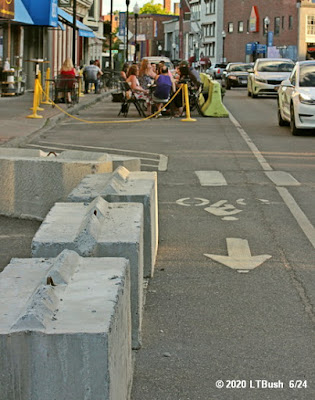©
2020 Luke T Bush
Images
from The Pepper Facebook page announcing the reopening of outdoor
seating.
PLATTSBURGH,
NY – 6/22/20
Outdoor
restaurant seating has returned to downtown Plattsburgh City – but
if you want to use the bike lanes on City Hall Place you're screwed.
Previously
the concrete barriers used to block off the outdoor seating areas on
both sides of the street left the bike lanes open. But this year –
probably due to Covid-19 restrictions – the barriers are also
blocking off the bike lanes.
As
you can see from the accompanying picture posted on Facebook
bicyclists are now forced to share the street with traffic. The
narrower free space means that cyclists will have to be extra careful
when traveling in either direction. Also it means that drivers will
have to wait for a slower moving cyclists when vehicular traffic
occupies both lanes – unless they want to force cycylists into the
concrete barriers.
In
the winter unshoveled sidewalks force pedestrians to walk in the
street. This has resulted in one fatality. With the busy traffic on
City Hall Place whom will be sued if someone loses life or limb?
And
there's the matter of the law. Here are some excerpts pertaining to
cyclists from the NYS
Vehicle & Traffic site:
Highway
Laws That Apply To A Bicyclist Access
Entitled
to Free Use Of Highways - Highway Laws Section 316
§
331. Consideration of complete street design.
For
all state, county and local transportation projects that are
undertaken by the department or receive both federal and state
funding and are subject to department of transportation oversight,
the department or agency with jurisdiction over such projects shall
consider the convenient access and mobility on the road network by
all users of all ages, including motorists, pedestrians, bicyclists,
and public transportation users through the use of complete street
design features in the planning, design, construction,
reconstruction and rehabilitation, but not including resurfacing,
maintenance, or pavement recycling of such projects.
Complete
street design features are roadway design features that accommodate
and facilitate convenient access and mobility by all users,
including current and projected users, particularly pedestrians,
bicyclists and individuals of all ages and abilities. These features
may include, but need not be limited to: sidewalks, paved shoulders
suitable for use by bicyclists, lane striping, bicycle lanes, share
the road signage, crosswalks, road diets, pedestrian control
signalization, bus pull outs, curb cuts, raised crosswalks and ramps
and traffic calming measures; and recognize that the needs of users
of the road network vary according to a rural, urban and suburban
context.
This
section shall not apply if it has been determined and set forth in
publicly available documents that one of the following exists:
i.
by bicyclists and pedestrians is prohibited by law, such as within
interstate highway corridors; or
ii.
the cost would be disproportionate to the need as determined by
factors including, but not limited to, the following: land use
context; current and projected traffic volumes; and population
density; or
iii.
demonstrated lack of need as determined by factors, including, but
not limited to, land use, current and projected traffic volumes,
including population density, or demonstrates lack of community
support; or
iv.
use of the design features would have an adverse impact on, or be
contrary to, public safety.
e.
Nothing in this section shall be construed to require the department
or agency with jurisdiction over a project to expend monies in
accordance with subdivision (a) of this section that exceed the
amount of state and federal funding for complete street design
features.
And
here's the relevant info from the NYS Complete Streets site:
Governor Andrew M. Cuomo signed the Complete Streets Act (Chapter 398, Laws of New York ) on August 15, 2011, requiring state, county and local agencies to consider the convenience and mobility of all users when developing transportation projects that receive state and federal funding. The New York State Department of Transportation (NYSDOT) is working to ensure that its policies and procedures meet the new standards. The initiative presents an opportunity to expand upon existing programs and collaborate with bicyclists, pedestrians, people with disabilities and others to identify best practices and designs for transportation facilities.
Sounds to me outdoor seating doesn't take preference over bike lanes.
I wonder how al fresco diners will react if an unfortunate cyclist is hit by a car and flies over the barrier into their table. For some the sight of blood will ruin their appetites.












